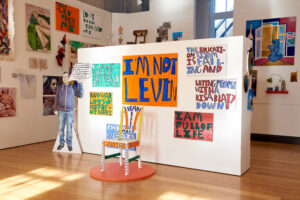
‘Becoming an “irregular” art school’ is a project at the University of Leeds.

It aims to recognise and celebrate learning-disabled artists.

The University has been working with Pyramid.

Pyramid is an arts studio for learning disabled people.

The project looks at ways to support their art careers.

In the podcast Dr Jade French talks with Vice-Chancellor Professor Simone Buitendijk.

Jade French is:
- an artist-facilitator
- practice-led researcher, and
- specialist in inclusive arts practice.

Inclusive arts happen around the world.
Learning disabled and neurodivergent artists create work with support from arts workers.
In the podcast they talk about how to bring the worlds of arts practice and social care support together.
social care support is like the NDIS.




